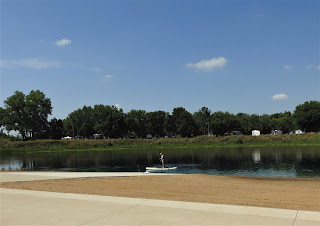If you have been waiting to hear some news, sorry, it doesn’t happen when I am spending time with my brothers and sisters. We parked Noobee in their drive for 5 days. Activities involved Back to the 50s Car Show and barbecues in the back yard with nieces, nephews, cousins and friends. Wonderful. Oh, and it rained cats and dogs for 2 of the days.
Now we are on the road heading west toward home. There were two options: taking the two legs of the triangle (south and then west) or the hippopotamus. Weeks ago, since I had found a campground on the hippopotamus in Le Mars, Iowa that might have a site available, I chose that route. It is a municipal park and the campground is situated around the edges of a cute little swimming hole called Willow Creek (paddleboarding?!) but, unfortunately, there were no vacant full hook-up sites. Nothing much is available this close to the 4th of July so we took a site with fewer amenities. Later, the manager called me. She said, “Good news! One of our long-term people won’t be here this summer and their full hook-up site is for rent! Do you want it?” Well, yeah! “Oh,” she said. “There’s one drawback.” Uh oh. “The site costs $30 instead of the usual $25.” Bingo! So, here we are for 3 nights at the municipal park in Le Mars, Iowa! It is sunshiny and warm! You may not appreciate this but for us, I think a little black rain cloud has been tethered to Noobee on this whole trip so far. Until now.
 |
| Rob lounges in the warm water at Willow Creek Campground. Noobee is just beyond the sand way back there. |
6-27-2023
We spent a large part of our day plotting the rest of the
trip. When we were done laying it out
and printing it, it was time to take a little swim and dig out the
paddleboards. By then, it was
raining.
6-28-2023
 |
| Fred H. Wells starts a dairy in 1913. |
Finally, a sunny day for us. After a bit of shopping to search for walleye and perch (No luck, there.) we discovered historic downtown which includes the Visitor Center and Blue Bunny Ice Cream Parlor. You see, in 1913, Fred H. Wells, who lived here and owned 15 dairy cows, decided to start a dairy. He paid $250 to a local farmer for, “one grey horse, one milk wagon, two barn cans, three 20 quart cans, sixty ½- pint jars…” With luck and elbow grease, Fred was a success and Wells ice cream became a big hit. In 1935, a contest was held to name Fred’s ice cream. George Vanden Brink, inspired by his kid’s fascination with the blue Easter bunnies in the store windows, suggested Blue Bunny. He won $25. Now, Blue Bunny produces more ice cream than any other single location on planet earth, 150 million gallons per year, enough to fill 225 Olympic-size swimming pools. In 1994, the Iowa State Legislature designated Le Mars, “The Ice Cream Capital of the World.” Naturally, Rob and I were obligated to visit the Visitor Center and Blue Bunny Ice Cream Parlor to share the delicious wealth, as it were. We now understand why there are painted ice cream cones on many corners throughout the city.
 |
 |
 |
| Le Mars, IA, Ice Cream Capital of the World! |
 |
| Just outside the Blue Bunny Ice Cream Parlor |
 |
| The gorgeous rich interior of the Blue Bunny Ice Cream Parlor |
I
 |
| Another ice cream cone. |
 |
| Ice cream cones on every corner |
It was hot and humid and back at camp, it was time to break out the paddleboards, beach chairs and a beer or two for a nice, lazy afternoon by the water. The sun cooperated!
 |
| Cooling down |
 |
| Hi Rob! |
 |
| Docking the "boat," as Rob calls it. |
Today (6-29), after one more quick paddle, we packed up
and are now driving through Nebraska. It
is absolutely beautiful: green, leafy,
healthy fields of happy crops. The corn
is not “knee-high by the 4th of July.” Here in Nebraska, it is “as high as an
elephant’s eye.” A good year for America’s
breadbasket. Thanks, Nebraska! We love it.
(Well, except for the UN Cornhuskers. They’re the enemy! Go Bucky!) Thunderstorms and possible hail for the next
two days. Sigh.
.JPG)
.JPG)








































